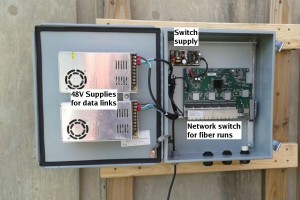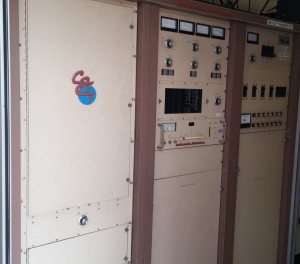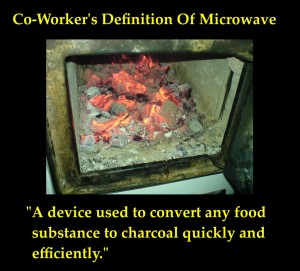 Building the power and network junction at the
Building the power and network junction at the
relay mid-point for a 45-mile 210 MB data link.
![]() (Click any of these illustrations for a larger image. Especially the monkeys.)
(Click any of these illustrations for a larger image. Especially the monkeys.)
A quick disclaimer: some of you have come here via a Google search. You’re experimenting with a switched-mode power supply (SMPS) and are looking for info.
There’s not a lot of Official Math(tm) here. This is primarily targeted to my fellow RF engineers, who’d like to get up to speed on SMPS stuff.
Be warned that I take liberties with strict technical accuracy. My RF background leaks through; for example, I often refer to all inductors as “coils,” whether they have actual coils of wire or not. (At microwave frequencies, in fact, a short trace on the PC board makes a dandy inductor.)
But I still recommend this to you. If you’ll read this first, you’ll understand intuitively what’s going on inside your SMPS. Then you can go to other sites, and look at all the Official Stuff(tm) to get the nitpickin’ details. I include links to other sites throughout this ditty.
The Great Gonkulator Saga
“Ain’t nothing sadder,” growls the PD (that’s a Program Director for you non-radio types), “than a Gonkulator what won’t gonk! (*Sniff!*) Look at it! Sittin’ there as dead and dark as … a … a dead thing! And a dark thing!”
“Not a problem,” you say confidently. “I’ve fixed a dozen of ’em. It’s the little switching supply.”
But Gonkulators, Inc is out of business and the original power supply is no longer available. You go online and search for a replacement — hey, here’s one that will do four times the current in the same size; that ought to last forever!
You install it. The Gonkulator lights up. “It’s ALIVE,” you cackle …
But there’s a strange whistle in the audio. You put capacitors on the supply outputs. The pitch drops, but it’s still there. You have to use some 100uF and 220uF caps to make it go away.
Just as you finish, a storm blows up. (Of course. Work in broadcasting for any time at all and you’ll learn to expect this.) The AC flickers a few times. The fuse blows. “This power supply is a piece of junk!”
 The disconsolate PD with
The disconsolate PD with
his dead, dark Gonkulator.
![]()
“Junk!”
Not necessarily. Sure, there are some bad supplies out there. I’ll have tips on how to choose one later. It’s also true that, years ago, switch mode power supplies were downright unreliable in general.
But in the main, SMPS are quite dependable nowadays if you choose and use them properly.
If you disagree and insist upon hating them, you are not only in a very small minority, it’s a waste of time. They’re here to stay.
(The machine that you’re using to read this — be it a desktop computer, a tablet or a smartphone — works well enough, doesn’t it? They all use switching supplies. Every one of them. Dell, Apple and Samsung seem to trust them.)
Let’s look at how they truly work … and at what makes them not work. (Spoilers: improper loading and localized overheating are two common causes.)
Having Fun
Designing a switched-mode (SMPS) supply is not an exact science. There’s an art to it. There is no “Single Good Way.” Each will have a recommended maximum and minimum load, temperature range, and all that.
My fellow RF engineers may argue that we won’t be building an SMPS. Most commonly, we’ll be selecting one as a replacement, or perhaps repairing a unit that has failed.
(Some might honestly think, “I have a transmitter with PWM modulators that can make 300 volts at 200 amps! What’s the big deal?” There are similarities … but some critical differences, too. For one thing, a typical 3×5 “brick” has strong, sharp current pulses concentrated in a very small area.)
I submit that knowing some of that “art” will help you to more intelligently choose or repair a supply. But most of all, I wrote this because I want you to have fun. So … have fun!
You don’t need all that brain-bending math, anyway. There’s a much easier way: SPICE modeling and a few shortcuts. I introduce you to LTSpice over here (it’s available as a free download from Linear Technology!); read that, then click here to proceed with a discussion of linear supplies.
 This older tube-type Continental Electronics
This older tube-type Continental Electronics
816-R4 transmitter uses a 3-phase switched
SCR system to control a 10,000V/5A supply.
(Picture taken at WYDE FM in Cullman, AL.)
![]()

